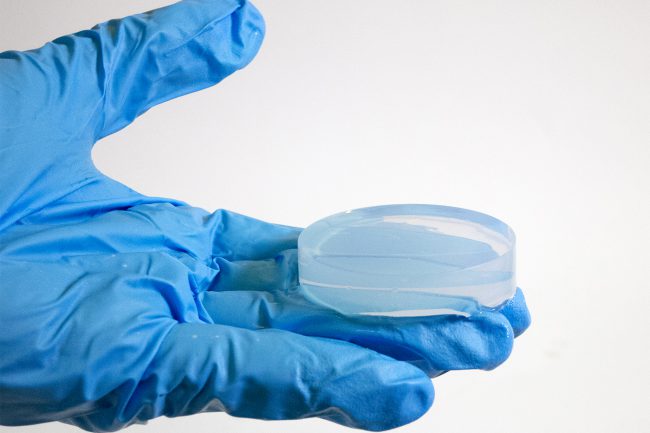the world’s lightest solid materials
Aerogels are an ultralight material, synthetically produced from a gel in which the liquid component has been removed without collapsing its structure. The transparent, porous material weighs only three times more than air and is hence among the lightest solids ever created.
Materials and Tools
|
|
The process and materials are for both a TEOS (A) and a water glass (B) precursor. The procedure is based on ambient pressure drying.
1A. TEOS sol
A 20ml TEOS gel is produced by mixing 7ml of P75E20 with 13ml of ethanol in a beaker which is placed on top of the magnetic stirrer. The mixture is then stirred for about 5 minutes at roughly 200rpm until everything is homogeneously dispersed. 12 drops (0.25ml) of ammonium hydroxide are added and the mixture is stirred for another 2-3 minutes. Once everything is smoothly diluted the mixture can be poured into the mould. The mould is heated in the oven at 55°C for 10 minutes until it has formed a gel.
1B. Water glass sol
In order to use water glass for aerogel production the pH level of the precursor has to be drastically reduced by performing an ion exchange. This is achieved by pouring 70ml of Amberlyst 15 hydrogen form into a gravity column that is fixed vertically on a stand. A beaker sitting on top the magnetic stirrer is placed beneath the column. The solution, which is prepared by mixing water glass and distilled water in a ratio of 1:2, is then slowly poured through the column while constantly stirring and measuring the pH level. The process has to be repeated by using fresh Amberlist columns until the pH level is below 4, preferably around 2.5 – 3. The resulting sodium silicate is a silicic acid.
20ml of the sodium silicate solution are poured into the mould which stands on the magnetic stirrer. While stirring the mixture for several minutes the pH level needs to be continuously checked. Several drops of ammonium are then added until the pH level has reached 5 – 5.5. The solution is placed into the oven at 55°C for 1 – 2 minutes until it has turned into a gel.
2. Ageing
The gel can be removed from the mould and placed back into a beaker. In order to prevent the occurrence of cracks the TEOS gel has to be covered with excess ethanol, the water glass gel with excess distilled water. The beaker needs to be closed with a piece of aluminium foil, which gets fixed with a rubber band. The gel is then kept in the oven at 55°C for 10 – 12 hours.
3. Solvent Exchange
After removing the gel from the oven it has to cool down until it has reached ambient temperature. In case of the TEOS gel, the ethanol solvent is replaced with n-heptane, in case of the water glass gel, the distilled water is swapped for ethanol. The beaker is again covered with the aluminium lid and placed back into the oven for 24 hours at 65°C.
For the TEOS gel, the previous step is repeated for a second time and again left in the oven for 24 hours at 65°C. For the water glass gel the ethanol is now exchanged with n-heptane and the previous step repeated twice (2x 24 hours in oven at 65°C).
From now on the process is the same for both gels.
4. Hydrophobization
This step marks the most crucial part of the whole process.
For 20ml of gel, the modification solution is prepared by mixing 50ml of n-heptane, 7.5ml of HMDSO and 4ml of a 0.1mol/l HCl/ ethanol solution. The HCl/ ethanol solution is made by filling a 100ml beaker with 10ml of HCl and 90ml of ethanol. All components are added to a beaker on the magnetic stirrer and kept stirred for at least 5 minutes until everything is dispersed equally.
The n-heptane solution of the gel can be discarded and is replaced with the previously prepared modification solution until the gel is completely covered. The beaker is again closed with the aluminium lid and placed back into the oven at 65°C for 24 hours.
5. Aerogel
After taking the gel out of the oven it is thoroughly washed and rinsed in n-heptane. The gel without any solvent or liquid is placed back into the beaker and covered with aluminium foil, which is fixed with a rubber band. The beaker goes back into the oven at 65°C for 2 more hours. The rubber band is then removed and the gel placed into the oven at 150°C for 2 final hours. The result is a (granular) aerogel.































